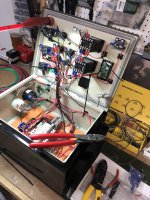Thank you for the mention, @Wizard_of_Frobozz. I am certainly biased, but I honestly think anyone building a panel should evaluate the benefits (and risks) of building with an automation-centric solution like CraftBeerPi, BCS, BrewTroller, or BruControl. The first benefit is that these systems create "virtual" control panels, replacing fixed hardware (LED's, switches, PIDs, timers, etc.) with software controls on a monitor. In terms of cost, it would be tough to compare because many brewers usually have some of the equipment needed for the interface (monitor, laptop, RPi, tablet, PC, etc.). If they didn't, the dedicated hardware might be less expensive. If they did however, I would bet the automation solution is cheaper. Look at the OP's post - there is ~$175 in dedicated hardware alone - replacing that with a BCS 460 is a dead-even cost exchange, and the builder picks up digital I/O, and remote interface, automated mash steps, and much more).
Now, with respect to the build, dedicated hardware requires the panel front be planned, drilled/punched, and wired. And the control box needs be mounted where the brewer can access it - typically on a well. Automation solutions requires only the "backplane" wiring. For example, my control box is under my table - out of the way and I never access it. So more time is needed setting up and executing the dedicated hardware build, but once it is done, the work is done. For automated solutions, there will inevitably be some learning curve along with setting up the software and dialing it in the way you want. So I would bet the initial build/setup time commitment is higher with the automated solutions. But you get a digital control panel that is how you want it - not some clone which is locked down.
Now where the real benefit to the automated breweries is the flexibility. Dedicated hardware does one thing, which is fine if that system is never going to change or grow. But what happens when you want to add features or functions to your build? Case in point this OP. For the automated solution, this gets really easy - just add the necessary backplane components (contactors, etc.), then set up the controls in software. In fact, I recommend any builder builds their box with expansion possibilities in mind. For example, rather than drilling holes for three temp probes, drill holes for 6 or 8. Add I/O holes for lots of expansion. I did this when I built my panel, not even knowing what I might expand into. I put in 16 I/O connectors, and as time has progressed, when I add something else (e.g. just added a second proportional valve), I just add the wires to the terminals and solder them to the connectors which are already in place. This requires no unplugging the box, drilling, painting, part relocation, etc. This is a huge benefit to the brewer who would like to automate more of their processes as time goes on.
Which I think is really the big consideration to be made. Do you see yourself adding more automation in the future? For example automatic timers, alarms, pump control, mash steps? Next would be electric valves to switch fluid flow without manual intervention. And beyond like vessel volume measurement, flow metering, etc. Heck, I am currently working on adding pH and SG measurement of the mash on the fly.
I know automation gets a bad rap, with comments like "I want to brew my beer, not have a machine do it", but I can tell you automation benefits the brewer in many ways - repeatibility being the most important of these. The second is freeing time and attention. Automation gives the brewer time to focus on the science and not be anchored down waiting for every step. Unfortunately, the human element introduces errors and new variables - so brewing the beer the way you want it, consistently from batch to batch, and changing only the variable you want becomes very feasible. For example, direct heating the mash with a propane burner will brew beer, but from brew to brew, you can't guarantee the temperature of the mash was maintained throughout, so while you intended to brew a dry beer, you get a big bodied one instead. Hence the evolution to electric brewing and temp control with PID's, etc. That was the first major step towards increased automation, and these solutions represent the next phase.
Anyway, I hope you don't mind the long post... just thought I would add some flavor for the OP and anyone contemplating their next build who is considering their control system.
















































![Craft A Brew - Safale BE-256 Yeast - Fermentis - Belgian Ale Dry Yeast - For Belgian & Strong Ales - Ingredients for Home Brewing - Beer Making Supplies - [3 Pack]](https://m.media-amazon.com/images/I/51bcKEwQmWL._SL500_.jpg)

















